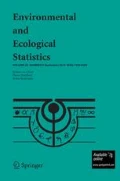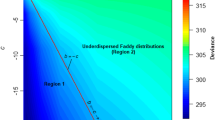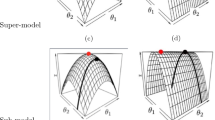Abstract
The proper management of an ecological population is greatly aided by solid information about its species' abundances. For the general heterogeneous Poisson species abundance setting, we develop the non-parametric mle for the entire probability model, namely for the total number N of species and the generating distribution F for the expected values of the species' abundances. Solid estimation of the entire probability model allows us to develop generator-based measures of ecological diversity and evenness which have inferences over similar regions. Also, our methods produce a solid goodness-of-fit test for our model as well as a likelihood ratio test to examine if there is heterogeneity in the expected values of the species' abundances. These estimates and tests are examined, in detail, in the paper. In particular, we apply our methods to important data from the National Breeding Bird Survey and discuss how our methods can also be easily applied to sweep net sampling data. To further examine our methods, we provide simulations for several illustrative situations.
Similar content being viewed by others
References
Boulinier, T., Nichols, J.D., Pollock, K.H., Sauer, J.R. and Hines, J.E. (1996) On the use of closed models of capture-recapture to estimate bird species richness: a test with large scale data. Unpublished manuscript.
Bulmer, M. (1974) On fitting the Poisson lognormal distribution of species-abundance data. Biometrics, 30, 101–10.
Burnham, K.P. and Overton, W.S. (1979) Robust estimation of population size when capture probabilities vary among animals. Ecology, 60(5), 927–36.
Bystrak, D. (1981) The North American Breeding Bird Survey. Studies in Avian Biology, 6, 34–41.
Dempster, A.P., Laird, N.M. and Rubin, D.B. (1977) Maximum likelihood estimation from incomplete data via the EM algorithm. Journal of the Royal Statistical Society, Series B, 39, 1–38.
Efron, B. (1981) Non-parametric estimates of standard error: The jackknife, the bootstrap and other methods. Biometrika, 68, 589–99.
Efron, B. and Thisted, R. (1976) Estimating the number of unseen species: how many words did Shakespeare know? Biometrika, 63(3), 435–47.
Engen, S. (1978) Stochastic Abundance Models, Chapman and Hall, London.
Fisher, R.A., Corbet, A.S. and Williams, C.B. (1943) The relation between the number of species and the number of individuals in a random sample from an animal population. Journal of Animal Ecology, 12, 42–58.
Kempton, R.A. and Taylor, L.R. (1974) Log-series and log-normal parameters as diversity discriminants for the Lepidoptera. Journal of Animal Ecology, 43, 381–99.
Lee, S. and Chao, A. (1994) Estimating population size via sample coverage for closed capture-recapture models. Biometrics, 50, 88–97.
Lindsay, B.G. and Roeder, K. (1992) Residual diagnostics for mixture models. Journal of the American Statistical Association, 87, 785–94.
Ludwig, J.A. and Reynolds, J.F. (1988) Statistical Ecology: A Primer on Methods and Computing, John Wiley and Sons, New York.
Mehninick, E.F. (1964) A comparison of some species individuals diversity indices applied to samples of field insects. Ecology, 45, 859–61.
Norris, J.L. and Pollock, K.P. (1996) Non-parametric MLE under two closed capture-recapture models with heterogeneity. Biometrics, 52, 639–49.
Preston, F.W. (1948) The commonness and rarity of species, Ecology, 29, 254–83.
Robbins, C.S., Bystrak, D. and Geissler, P.H. (1986) The breeding bird survey: its first fifteen years, 1965–1979. U.S. Fish and Wildlife Service, Resource Publication 157, Washington, D.C., USA.
Romano, J.P. (1988) A bootstrap revival of some non-parametric distance tests. Journal of the American Statistical Association, 83, 698–708.
Shannon, C E. and Weaver, W. (1949) The Mathematical Theory of Communication, University Illinois Press, Urbana, Il.
Sichel, H. (1991) Modelling species-abundance frequencies and species-individual functions with the generalized inverse Gaussian-Poisson distribution law. Unpublished manuscript, University of the Eitwatersrand, South Africa, Department of Statistics and Actuarial Science.
Simpson, E.H. (1949) Measurement of diversity. Nature, 163, 688.
Taylor, L.R., Kempton, R.A. and Woiwod, I.P. (1976) Diversity statistics and the log-series model. Journal of Animal Ecology, 45, 255–72.
Titterington, D. M. (1991) Some recent research in the analysis of mixture distributions. Statistics, 21, 619–41.
Titterington, D.M., Smith, A.F.M. and Makov, U.E. (1985) Statistical Analysis of Finite Mixture Distributions, John Wiley and Sons, Chichester, England.
Author information
Authors and Affiliations
Rights and permissions
About this article
Cite this article
Norris, J.L., Pollock, K.H. Non-parametric MLE for Poisson species abundance models allowing for heterogeneity between species. Environmental and Ecological Statistics 5, 391–402 (1998). https://doi.org/10.1023/A:1009659922745
Issue Date:
DOI: https://doi.org/10.1023/A:1009659922745




